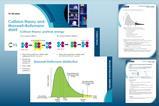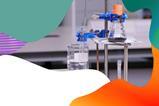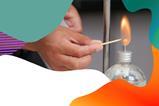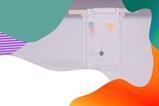Learn how to identify metal and non-metal ions in unknown solutions
This video shows how to use flame tests and chemical tests to identify both metal and non-metal ions. Once your students understand how to use flame and chemical tests, they will be able to investigate how a combination of these tests can be used to work out the metal and non-metal parts of an unknown solution.
Chapter titles: 00:10 Introduction; 01:12 Flame tests for metal ions; 04:38 Metal hydroxide precipitate test; 07:56 Testing for negative ions; 11:54 Unknown substances.
Download additional resources
Supporting resources booklet including pause-and-think questions with answers, teacher notes, intended outcomes, follow-up worksheets and structure strips. Plus technician notes and integrated instructions. Editable versions of all worksheets and key documents are provided.
Teacher notes
Full teacher notes are available in the supporting resources booklet, including ideas for how to use this video and the supporting resources as part of your teaching.
Notes on running the practical experiment
Technician notes and integrated instructions are available to support all of the tests in this video.
The flame tests (wooded splint method) take about 10 minutes to carry out and it is safe for learners to work in pairs.
The microscale sodium hydroxide test for positive ions reaction takes around 10 minutes and it is safe for learners to work in pairs. This should be carried out on either the printable sheet (in this booklet) or on the integrated instruction sheet. In both cases you will need to either put the printed sheet into a plastic wallet or laminate it.
TIP Printing the microscale sheet/integrated instructions onto buff coloured paper will make it easier to see when a white precipitate has been formed.
TIP Once completed learners can take a photo of their results using a mobile phone or tablet, so that they can clear away immediately. This will help avoid learners spilling chemicals on their results table.
Allow 30 minutes for the testing of negative ions, 10 minutes for each test. You may wish to carry out this experiment in a separate lesson. This will give you time to go over the theory in the same lesson.
Once all the tests have been completed, provide the class with an unknown solution X and ask the students to identify either the positive ion present, the negative ion present or both.
Further practical activities
Find details of alternative methods to carry out the flame tests; this activity makes a good plenary or starter; asking students to name the metal ion as they see the different flame colours. The flame tests infographics is a great reference sheet and also explains the chemistry behind the flame colours. You may also be interested in the exhibition chemistry video Rainbow flame demonstration, which provides a wonderful display of colours as well as further details of the chemistry of flame tests.
Real-world contexts
- Alongside his studies towards a chemistry degree, Joseph works in the lab carrying out vital safety tests on drinking water for 15 million people at the UK’s largest water and wastewater company.
- Learners take the role of forensic scientists to help investigate a crime and solve a case in this crime scene activity featuring flame tests.
- A pyrotechnician is an artist, a craftsperson, but also a scientist of sorts. Learn about fireworks: the art and science with this article and resource. Discover more in our fireworks collection.
- Hundreds of different chemicals can ruin our water, so measuring their levels is vital. This article investigates whether building sensors that can do the job cheaply and remotely will ever be possible.
- Explore the history of the discovery of caesium by Carl Setterberg in 1881 using flames colours and spectroscopy.
Key terms
Learners will need to have a clear understanding of the following scientific terminology:
ion – a positively or negatively charged particle
metal halide – general term used to describe the group of ionic compounds that form when a metal reacts with a halogen.
ionic compound – a compound made up of oppositely charged ions. Ionic compounds are held together by strong electrostatic forces between oppositely charged ions. These forces are called ionic bonds.
aqueous solution – a solution where the solvent is water. So an aqueous solution of sodium hydroxide contains Na+ ions, OH- ions and H2O molecules.
precipitate – a solid that forms from ions in an aqueous solution. The precipitate is insoluble in water.
ionic equation – a symbol equation which focuses on the ions that react together and ignore the ones that do not take part in the reaction (spectator ions).
Prior knowledge
Learners should be able to recall:
- Particles can be atoms, molecules or ions.
- An ion is a positively or negatively charged particle.
- An atom or a molecule can lose or gain electron(s) to form an ion.
- When an atom/molecule gains negatively charged electron(s), a negative ion is formed. When an atom/molecule loses negatively charged electron(s), a positive ion is formed.
- A solution is formed when a solute (salt) is dissolved in a solvent (water).
Learners should be confident writing word and symbol equations
There are some questions included which ask learners to balance symbol equations and write ionic equations. Depending on where the identification of ions comes in your scheme of work your learners may not have come across this yet. Adapt the questions to make them relevant to the stage and level that you are at. Some of the challenge tasks require learners to use and apply their knowledge from other topics.
Common misconceptions
1. When an atom/molecule loses negatively charged electron(s), a positive ion is formed. This is something learners often struggle with later on in their studies. Introducing the electron now, before learners meet the other sub-atomic particles, can help to embed the idea that the loss of electrons results in a positively charged ion, and may help reduce confusion later on.
2. As learners develop their understanding of chemical bonding further, it is common for students to refer to ionic compounds as molecules or to refer to intermolecular forces when explaining properties of ionic compounds. To avoid these misconceptions introduce and emphasise the correct use of the terms ‘ion’ and ‘molecule’ from the outset.
3. Learners often find solution chemistry challenging as they fail to appreciate that, as well as the ions taking place in the precipitate reaction, both water molecules and spectator ions are also present.
Diagnostic multiple-choice questions are a great way to explore learners’ misconceptions by investigating reasoning behind their answers. Read more about diagnostic questioning.
Downloads
Identifying Ions: supporting resources
Handout | PDF, Size 0.32 mbIdentifying ions: technician notes_1
Handout | PDF, Size 1.65 mbIdentifying ions: integrated instructions
Editable handout | PowerPoint, Size 0.43 mbIdentifying ions: pause-and-think questions
Editable handout | Word, Size 0.12 mbIdentifying ions: intended outcomes
Editable handout | Word, Size 0.11 mbIdentifying ions: follow-up worksheet
Editable handout | Word, Size 0.12 mbIdentifying ions: structure strips
Editable handout | Word, Size 0.11 mbIdentifying ions: printable results tables
Editable handout | Word, Size 0.11 mbIdentifying ions: Johnstone's triangle
Editable handout | PowerPoint, Size 0.1 mb
Additional information
Real-world contexts added by Ian McDaid.


Practical videos | 14–16 years

Videos of core practical experiments for flipped learning, remote teaching or revision
- 1
- 2
- 3
- 4
- 5
- 6
- 7
- 8
 Currently
reading
Currently
reading
Identifying ions
- 10
- 11
- 12
- 13
- 14




















































No comments yet